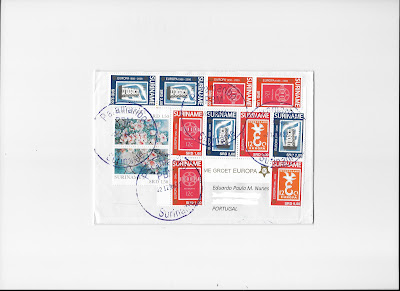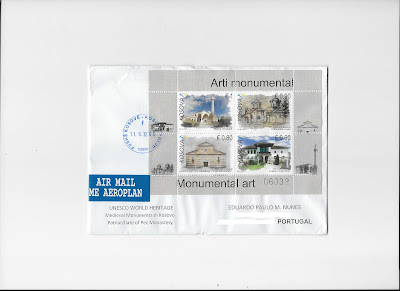Thursday 29 December 2022
INDONESIA
This cover from Indonesia depict a miniature sheet issued in 2022 celebrating the UNESCO Global Geopark of Belitong.
SURINAME
An amazing cover with 12 stamps affixed on letter, coming from Suriname. This is my first cover from this country in South America, a former dutch colony. Suriname is a country on the northeastern Atlantic coast of South America. It is bordered by the Atlantic Ocean to the north, French Guiana to the east, Guyana to the west, and Brazil to the south. At just under 165,000 square kilometers, it is the smallest sovereign state in South America.
It has a population of approximately 620,000, dominated by descendants from the slaves and labourers brought in from Africa and Asia by the Dutch Empire and Republic. Most of the people live by the country's (north) coast, in and around its capital and largest city, Paramaribo. It is also one of the least densely populated countries on Earth.
POLAND
This cover from Poland depict a se-tenant joint issue with Croatia on motive "Sources of Salt". The "4 zt" stamp on the right corner shows a picture of the Bochnia Royal Salt Mine in Poland, one of the oldest salt mines in the world and also the oldest commercial company in Poland. The Bochnia salt mine was established in 1248 after salt had been discovered there in the 12th and 13th centuries, and became part of the royal mining company. In 1990 the mine ceased producing salt but remains a tourist attraction. In 1981 the Bochnia salt mine was declared a heritage monument. It is one of Poland's official national Historic Monuments, as designated on 6 October 2000, and is overseen by the National Heritage Board of Poland. In 2013 the mine was added to the UNESCO World Heritage List as an extension of the Wieliczka Salt Mine inscription of 1978.
AUSTRIA
This cover from Austria depicts 2 stamps, including the orange stamp on the right celebrating the "Seewinkel National Park", a part of the World Heritage Site Ferto /Neusiedlersee Cultural Landscape. The Fertö/Neusiedler Lake area has been the meeting place of different cultures for eight millennia. This is graphically demonstrated by its varied landscape, the result of an evolutionary symbiosis between human activity and the physical environment. The remarkable rural architecture of the villages surrounding the lake and several 18th- and 19th-century palaces adds to the area’s considerable cultural interest. The site is inscribed as a UNESCO World Heritage site since 2001.
Monday 12 December 2022
P. R. CHINA
This cover fom China depicts 5 stamps of same type celebrating the World Heritage Site South China Karst. The South China Karst, a UNESCO World Heritage Site since June 2007, spans the provinces of Chongqing, Guangxi, Guizhou, and Yunnan. It is noted for its karst features and landscapes as well as rich biodiversity. The site comprises seven clusters Phase I: Libo Karst, Shilin Karst, and Wulong Karsit nscribed in 2007, and Phase II: Guilin Karst, Shibing Karst, Jinfoshan Karst, and Huanjiang Karst inscribed in 2014. UNESCO describes the South China Karst as "unrivalled in terms of the diversity of its karst features and landscapes.
Etiquetas:
China,
China - South China Karst,
Unesco World Heritage
KOSOVO
This cover came from Kosovo and features a miniature sheet issued in 2017 celebrating the "Patriarchate of Pec Monastery", some of the monuments included at the UNESCO world heritage site known as "The Medieval Monuments in Kosovo". The Medieval Monuments in Kosovo are a World Heritage Site consisting of four Serbian Orthodox Christian churches and monasteries which represent the fusion of the eastern Orthodox Byzantine and the western Romanesque ecclesiastical architecture to form the Palaiologian Renaissance style. The construction was founded by members of Nemanjić dynasty, the most important dynasty of Serbia in the Middle Ages. The sites are located in the modern-day Kosovo. In 2004, UNESCO recognized the Dečani Monastery for its outstanding universal value. Two years later, the site of patrimony was extended as aerial nomination, to include three other religious monuments: Patriarchate of Peć Monastery, Our Lady of Ljeviš and Gračanica Monastery. In 2006 the property was inscribed on the list of World Heritage in Danger due to difficulties in its management and conservation stemming from the region's political instability.
There is also an ongoing controversy over Kosovo's bid to join the UNESCO, which would result in the sites being listed as part of Kosovo and not Serbia. These monuments have come under attack, especially during the ethnic violence in 2004, during Kosovo's UNMIK rule, when the Our Lady of Ljeviš was heavily damaged. In October 2015 Kosovo was recommended for membership by the UNESCO Executive Board bus UNESCO has not accepted Kosovo as a member.
Sunday 4 December 2022
SPAIN
This beautiful cover came from Spain and depicts a miniature sheet issued in 2010 celebrating the Mosque-Cathedral of Córdoba. The historic centre of Córdoba is one of the largest of its kind in Europe. In 1984, UNESCO registered the Mosque–Cathedral of Córdoba as a World Heritage Site. A decade later, it expanded the inscription to include much of the old town. The historic centre has a wealth of monuments preserving large traces of Roman, Arabic, and Christian times.
Etiquetas:
Spain,
Spain - Historic Centre of Córdoba,
Unesco World Heritage
Thursday 1 December 2022
UNITED NATIONS (VIENNA OFFICE)
THis amazing cover from United Nations (Vienna Office) depicts a complete set issued in 2006 celebrating 6 UNESCO World Heritage Sites in France: Mount Saint-Michel and its Bay, Paris, Banks of the Seine, Pont du Gard (Roman Aqueduct, Historic Fortified City of Carcassonne, Provins, Town of Medieval Fairs and the Chambord Castle, a part of the site The Loire Valley between Sully-sur-Loire and Chalonnes.
AUSTRIA
This cover from Austria depicts a single stamp issued in 2022 celebrating the Augustiner Braustübl Mülln. Since 1621, this is the Austria's biggest beer tavern, in Salzburg’s Mülln neighbourhood. With an indoor seating area of 5.000 m2, the Bräustübl tavern and Brewery is Austria’s largest and boasts a further 1400 seats in the outdoor beer garden. The beer is drawn from wooden barrels and served in stone jugs, or steins. Regional and traditional dishes can be bought directly from various food stands in the "Schmankerlgang" (Delicatessen arcade) which is set up to resemble a traditional marketplace. The Bräustübl is a well-respected traditional meeting place – a piece of living history in the world heritage centre of Salzburg.
GERMANY
A cover from Germany with a special postmark celebrating the 1200th. anniversary of the Princely Abbey of Corvey. The Princely Abbey of Corvey (German: Fürststift Corvey or Fürstabtei Corvey) is a former Benedictine abbey and ecclesiastical principality now in North Rhine-Westphalia, Germany. It was one of the half-dozen self-ruling princely abbeys of the Holy Roman Empire from the late Middle Ages until 1792 when Corvey was elevated to a prince-bishopric. Corvey, whose territory extended over a vast area, was in turn secularized in 1803 in the course of the German mediatisation and absorbed into the newly created Principality of Nassau-Orange-Fulda. Originally built in 822 and 885 and remodeled in the Baroque period, the abbey is an exceptional example of Carolingian architecture, the oldest surviving example of a westwork, and the oldest standing medieval structure in Westphalia. The original architecture of the abbey, with its vaulted hall and galleries encircling the main room, heavily influenced later western Romanesque and Gothic architecture. The inside of the westwork contains the only known wall paintings of ancient mythology with Christian interpretation in Carolingian times. The former abbey church was listed as a UNESCO World Heritage Site in 2014.
BRAZIL
This cover from Brazil depicts 2 stamps. The small stamp of 0,23 R$ shows a picture of the Pantanal. The Pantanal Conservation Area is a natural region encompassing the world's largest tropical wetland area, and the world's largest flooded grasslands. It is located mostly within the Brazilian state of Mato Grosso do Sul, but it extends into Mato Grosso and portions of Bolivia and Paraguay. It sprawls over an area estimated at between 140,000 and 195,000 square kilometres. Various subregional ecosystems exist, each with distinct hydrological, geological and ecological characteristics; up to 12 of them have been defined. Roughly 80% of the Pantanal floodplains are submerged during the rainy seasons, nurturing a biologically diverse collection of aquatic plants and helping to support a dense array of animal species. Pantanal Conservation Area was declared a UNESCO World Heritage Site in 2000.
Subscribe to:
Posts (Atom)











